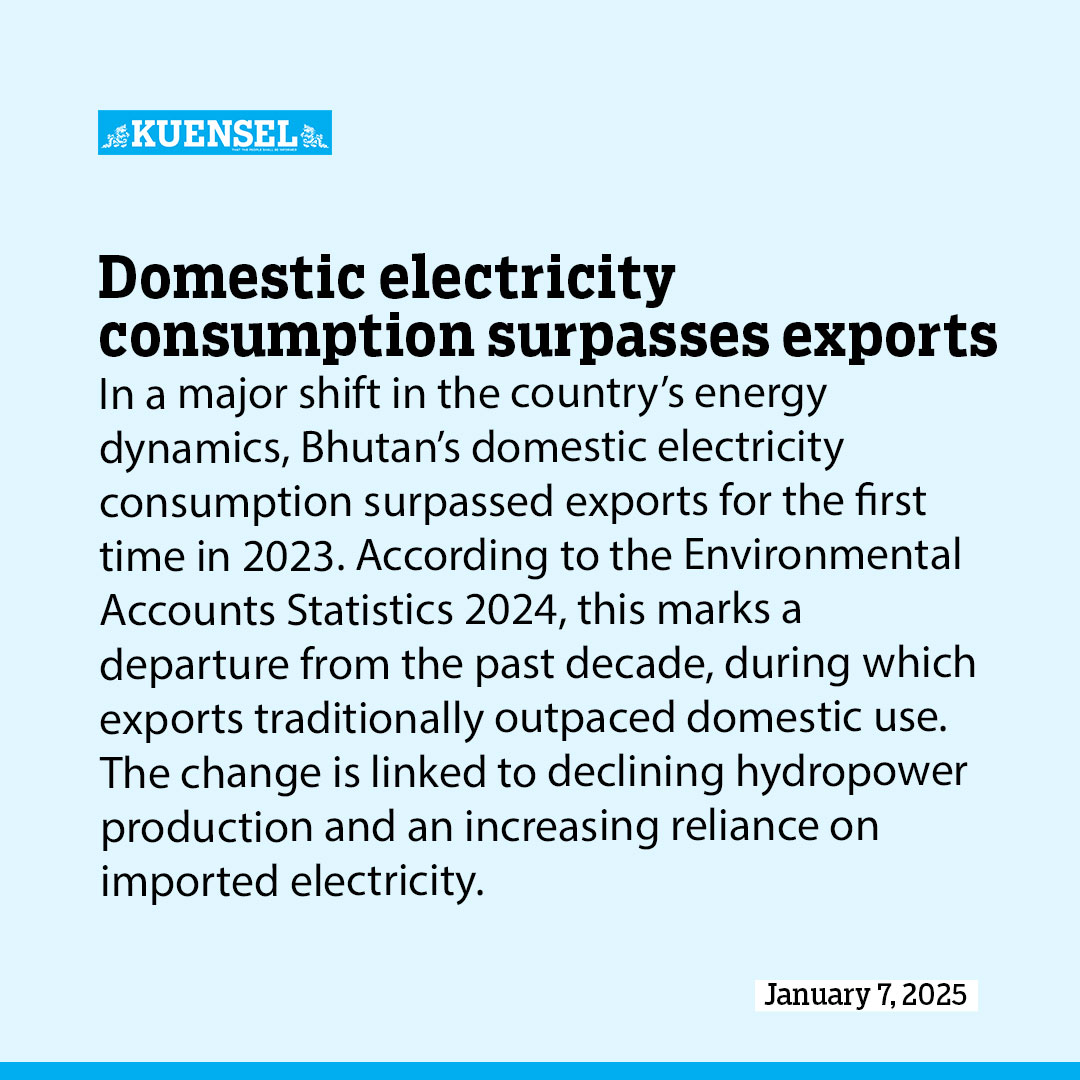Bhutan’s energy demand could grow by more than 400 percent by 2030 if consumption peaks as expected
Yangyel Lhaden
In a major shift in the country’s energy dynamics, Bhutan’s domestic electricity consumption surpassed exports for the first time in 2023.
According to the Environmental Accounts Statistics 2024, this marks a departure from the past decade, during which exports traditionally outpaced domestic use. The change is linked to declining hydropower production and an increasing reliance on imported electricity.
The Department of Hydropower Systems projects that Bhutan’s energy demand could grow by more than 400 percent by 2030 if consumption peaks as expected.
The surge in domestic demand over the years is primarily driven by the growing industrial sector, which accounted for 93.84 percent of the total domestic electricity consumption in 2023. In contrast, household consumption comprised only 6.17 percent, relying more heavily on fossil fuels and fuelwood for energy needs.
In 2023, a total of 11,157 gigawatt-hours (GWh) of hydroelectricity were supplied. Of this, 622 GWh were imported, 5,895 GWh were consumed domestically—with 5,531.98 GWh by industries and 364 GWh by households— and 5,143 GWh were exported.

As the world transitions toward cleaner energy sources under the Paris Agreement, Bhutan’s reliance on renewable energy—primarily hydropower—remains central to its energy mix. In 2023, electricity accounted for 70.26 percent of the country’s total energy demand, which also includes diesel, petrol, kerosene, and fuelwood.
However, increasing domestic demand is placing considerable strain on the existing hydroelectric resources. Alternative renewable energy sources like solar and wind contribute less than one percent to the overall energy mix, according to the Bhutan Energy Data Directory 2022.
In addition, electricity generation has been steadily declining over the years, while imports are increasing.
In 2021, the overall generation of hydropower was 10,821.80 GWh, while imports were relatively minimal at 25.19 GWh. In 2022, production slightly decreased to 10,754.05 GWh, but imports rose significantly to 247.32 GWh. By 2023, production continued to decline to 10,535.60 GWh, while imports saw a sharp increase, reaching 622.00 GWh.
This rising domestic consumption and reduced exports also have implications on the hydropower revenue since export tariffs are higher than domestic tariffs.
Revenue from electricity exports dropped from Nu 22.6 billion in 2022 to Nu 16.64 billion in 2023, while domestic sales nearly doubled, from Nu 4.41 billion in 2022 to Nu 8.73 billion in 2023.
Despite the increased demand, household-level use of electricity is still lower. Households used 364 GWh or 6.17 percent of total domestic consumption of hydroelectricity.
The demand for kerosene and liquefied petroleum gas among households also declined over the years, according to the report.
The household sector ranked second, accounting for 24.20 percent of fossil fuel consumption—diesel and petrol—while the service sector accounted for the largest share at 35.96 percent. The total diesel and petrol imported in 2023 was 210,147 kilolitres (KL), an increase from 144,340 KL in 2022.
The report states that this reliance on fossil fuels will continue until electric vehicles become more affordable.
The transport sector alone emitted approximately 130 million kilogrammes of carbon dioxide in 2023.
In the 13th Plan, the government plans to construct 10 large hydropower projects. And if everything pans out as planned, Bhutan will generate more than 10,000 MW of electricity once these hydropower projects are commissioned.













